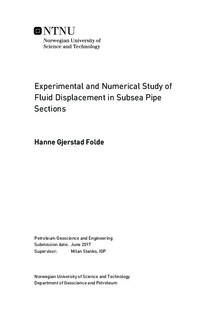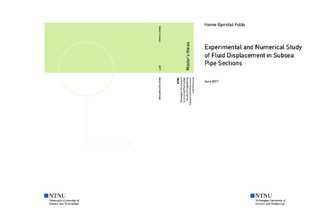| dc.description.abstract | The objective of the thesis is to study displacement operations in offshore petroleum industry. Typically MEG or Methanol is circulated through parts of the subsea production systems to lower their hydrocarbon content. This is often done at the beginning of a prolonged production shut-in, to avoid formation of hydrates or to minimize the emissions of chemicals to the environment when a component is to be replaced.
Experimental and numerical analyses have been conducted on a previously built pipe system formed like a U-shaped jumper. Through the project it has been investigated necessary displacing time required to achieve target hydrocarbon concentration in the domain, optimal displacement rate for efficiently removal of hydrocarbons, and how these variables depend on different fluids and their properties. The investigation was performed through measuring the volume fraction in the domain of the displacing fluid by draining the jumper, after the fluid had been flooding in the system for a certain time. The system was filled and displaced with both water and Exxsol D60. The experimental results have been used as validation for the accuracy of the models made in the transient multiphase flow commercial simulator LedaFlow®. A sensitivity analysis was performed, considering density, viscosity, interfacial tension, different fluids and geometry.
The experimental results showed small changes in the amounts displaced between 2 and 3 volumes. For the displacement to be considered successful, a criterion of a volume fraction for the displacing fluid higher than 95 % was set. For oil displacing water, a flow rate of 28.16 m3/h was required. For water displacing oil, 20.77 m3/h was sufficient. LedaFlow predicted the volume fractions well, deviating from the experimental points with an average of 5.5 % for oil displacing water and 5.7 % for water displacing oil. The sensitivity analysis showed significant changes in the displaced amounts, when changing the density of the displaced fluid. For a density a bit higher than the displacing fluid, the amount was decreasing exponentially as the density increased. Changes in viscosities for both the displacing fluid and the fluid to be displaced had little effect, unless the viscosity of the displacing fluid was highly increased. It was observed a linear relationship between changes in interfacial tension and obtained volume fraction. Simulations with methanol displacing oil predicted higher amounts displaced than when oil displaced water. With gas included as a fluid to be displaced in the system, the displaced amounts were reduced. With a dead-leg included in the geometry, it showed no visible effects in the simulation.
Experimental data and observations have been obtained. The results of the numerical models in LedaFlow are in good agreement with the experimental data. | |

